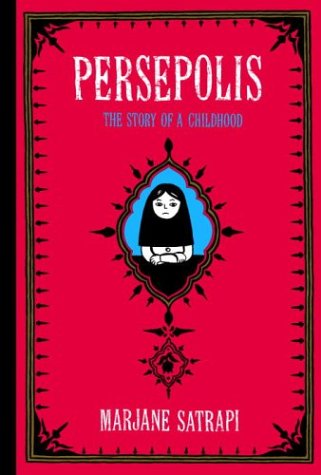“. . . Since then, (1979, after the Shah fled Iran to escape the Islāmic revolution), this old and great civilization has been discussed mostly in connection with fundamentalism, fanaticism, and terrorism. As an Iranian who has lived more than half of my life in Iran, I know that this image is far from the truth. This is why writing Persepolis was so important to me. I believe that an entire nation should not be judged by the wrongdoings of a few extremists. I also don’t want those Iranians who lost their lives in prison defending freedom, who died in the war against Iraq, who suffered under various repressive regimes, or who were forced to leave their families and flee their homeland to be forgotten.
One can forgive but one should never forget.”
~From the introduction of THE COMPLETE PERSEPOLIS
Marjane Satrapi, Paris, September 2002
 Graphic Novel, Memoir
Graphic Novel, Memoir
by Marjane Satrapi
Copyright © 2000 in French, by L’Association, France
Persepolis English translation copyright © 2003 by L’Association, France
Published in the United States by Pantheon Books, a division of Random House
Age Range: 11 years-adult
Grade Level: Middle Grade-Adult
Text and illustrations by Marjane Satrapi
AWARDS
Prix Alph’art Coup de Coeur at Angoulême
Prix du Lion in Belgium
Prix Alph’art du meilleur scénario
The Prix France Info
The Young Adult Library Association Recommendation
Named one of “100 Best Books of the Decade” by The Times (London)
Winner of the 2003 Fernando Buesa Peace Prize (Spain)
A New York Times Notable Book
A Time Magazine “Best Comix of the Year”
WHY PERSEPOLIS:THE STORY OF A CHILDHOOD IS A KEM GEM
KRISTI’S TAKE
Marjane Satrapi’s autobioGRAPHIC novel is: an art form with comic content, a coming of age narration, illustrative of revolutionary Iran, unique, historical, and provocative! Reading it felt a bit like scanning a box of Satrapi’s neatly organized film negatives. The sparse and purposeful word choice intensifies Satrapi’s high-contrast inking. The wedding of her visual and literary style provides the perfect medium to unveil BOLD commentary about how the Islāmic Revolution tainted childhood innocence. Although this rebellious first person narration is rendered in black & white, PERSEPOLIS delves into the murky greyness of political conflict; a YA must read!Click here for chapter summaries.
Favorite line
“The revolution is like a bicycle. When the wheels don’t turn, it falls.”
ELISE’S TAKE
Although PERSEPOLIS is heavy with political and social issues, Marjane Satrapi’s childlike perspective is still refreshing and relatable. She gives readers an honest and poignant look at the traditions that suppress many in her distant Iranian culture. Simultaneously, we also read about a girl whose struggle with identity and security is not so different from our own. Marji’s experiences of making friends and understanding political changes, as well as her quest for independence and respect are universal themes to which readers of all ages will relate.Visually, PERSEPOLIS is a marvelous spin on the traditional memoir. The graphic layout offers a genre for young readers who still crave visual references at an age when other illustrated books may appear childish. The images give a youthful quality to some difficult subjects, yet the novel remains sophisticated in its simple, organized presentation.
Favorite line
“I tell you all this because it’s important that you know. Our family memory must not be lost. Even if it’s not easy for you, even if you don’t understand it all.”
MARRAS’ TAKE
Because this graphic memoir lives up to its genre, PERSEPOLIS: THE STORY OF A CHILDHOOD makes a riveting read for all middle grade through adult readers. In this, Satrapi relives her childhood in a country gone mad. Satrapi explains the complexities of war, politics, Iranian history, and culture through reflective but stark black and white comic strips. The absence of red, the color of gore and bloodshed, mercifully buffers readers from the unspeakable suffering inflicted by the Islāmic Revolution. The absence of censorship thwarts the aggrandizement of war. Satrapi’s humor serves as an unexpected encourager, prodding us forward with hope.As a child, Marjane Satrapi desired to become a prophet. As a young adult she desired to become a revolutionary. In her own way, she accomplished both.
Favorite line
“It was funny to see how much Marx and God looked like each other. Though Marx’s hair was a bit curlier.”
Did you know that, pre-1979, Iranian women and girls were free to dress as they chose?  Young adult and older readers enjoy The Complete Persepolis, which includes Persepolis: The Story of a Childhood and Persepolis 2: The Story of a Return.
Young adult and older readers enjoy The Complete Persepolis, which includes Persepolis: The Story of a Childhood and Persepolis 2: The Story of a Return.
If you’ve already read the story, I highly recommend watching The Complete Persepolis motion picture, winner of the Cannes Film Jury Prize in 2007. Your heart will break for the plight of the Iranian people while you fall in love with Marjane, her colorful grandmother and her courageous family. The artistically exquisite movie provides a perfect summary and refresher after reading the two-part memoir.
INTERVIEW WITH MARJANE SATRAPI
Please share your Persepolis comments, too!



